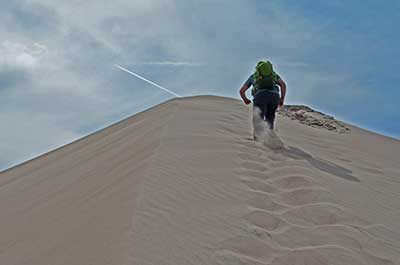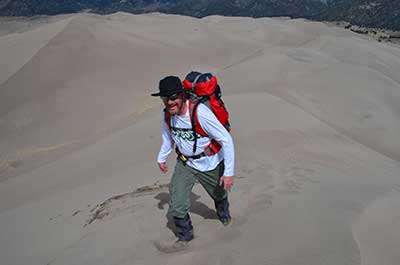As I slogged into a 15mph breeze among North America‘s tallest sand dunes, my every footfall kicked up a cloud of fine sand which was caught by the wind and carried back into my lower legs. Until the serious climbing began, I felt a little thrill with every footfall in seeing all that sand carried into my REI Mountain boot gaiters instead of my pant legs and thence, boots.
Thanks in part to the ~30lb backpack I unwisely brought along for added challenge, steep ascents found my boots disappearing at least past the ankle. Though I went for the tall gaiters, I really didn‘t expect that to help as I imagined sand infiltrating from the bottom.
Fear: misplaced. I made the top of the 700‘ dune which was our destination without feeling anything but socks and feet in my boots. The wind was much stronger up there, making it a great day for long sleeves and pants.

The return slog is where the real test came: the steep descents. Ascending, we‘d gone out of our way to avoid climbing as many really steep faces as possible, sticking to ridge lines and flats where we could. Returning, we simply slogged down the steep slopes. I had no idea sand could get so deep!
It turns out that when you plunge a leg into sand deeper than your calves, it groans much like deep snow will. Unlike deep snow, however, sand is heavy! It embraced my lower legs with a sensation much like thin waders in a stream, reaching almost to my knees with every footfall on the really steep descents.
Back at the Visitor‘s Center, I was amazed to find no sand in my boots/socks. A few hundred grains had infiltrated beneath the gaiters to speckle my pant legs, but nothing at all made it into my boots. I understand per prior research that this performance is not remarkable, nor limited to this or that brand, but more the result of good design and fitment.
By way of comparison, one companion with no gaiters and modern, mid-height hiking boots, ended up with ‘˜some‘ sand in his boots after the descent. Another companion with a borrowed, 20 year old set of gaiters over modern low top hikers ended up dumping rivers of sand from both shoes after the descent.

It‘s worth adding that these are my first set of gaiters, purchased privately for the sand dunes trip. Though I began my research and originally intended to buy online, I ultimately visited a store in person after reading about fitment issues in reviews. Rather than chase down size charts and so forth, I donned my boots and headed for the store.
It is well that I did! I‘d initially settled on another brand, but when I tried them on, I was unable to get any of the 3 available models to fit me correctly. I tried both L and M sizes but couldn‘t seem to get a good fit with any of the models I tried. Don‘t read that as criticism of this unnamed brand, though. My research and online reviews seem to indicate that variations in human physiology and body dimensions mean that some brands simply work better for some people than for others.
In any event, REI‘s Mountain gaiters went on perfectly first try, and seemed to fit well. Unlike the other models which snug to the upper leg with a finger-width strap and buckle, REI‘s version offers a shock cord with adjustment by pinch buckle. Where the other offerings were either too small or too big on my legs, the Mountain Gaiters required little in the way of adjustment.
In researching, I‘d been concerned that the shock cord would hinder circulation in my legs. Since the other brand didn‘t fit, I decided to take a chance. My concerns appear to have been misplaced: I had no trouble with circulatory loss, nor with keeping the gaiters from sliding down my legs. They remained in place through my dunes hike without adjustment or intervention. Ditto the following day, when we did a short trail hike to a local frozen waterfall.
My testing was conducted with *F temperatures in the mid 40s. Warmer weather may bring heat-related discomfort.
The gaiters fasten in front with a wide strip of hook and loop and loop material. A sturdy foot strap with a buckle offers vertical adjustment. To put them on, I tear open the hook and loop, then settle the heel strap and heel into place on my boot before attaching the lace loop in front, then carefully uniting the hook and loop strips.
Pull the lower adjustment loop across the top of the foot and snug it in its own hook, then adjust the shock cord to fit your upper legs, tuck the elastic loops into the gaiters, and you‘re ready to hike.
In conclusion, I‘m a fan! I‘m not sure how I went as long as I have without knowing about gaiters, but when I first put them on in the store, I found my mind wandering through a litany of past destinations and hikes when they‘d have saved me a lot of discomfort and effort spent removing undesirable crap from my shoes.
From sand spurs in Florida to goat heads in New Mexico and oodles of sand in Arizona, I‘ve needed these things for a long time, just never knew it. Find yours here.
Matt